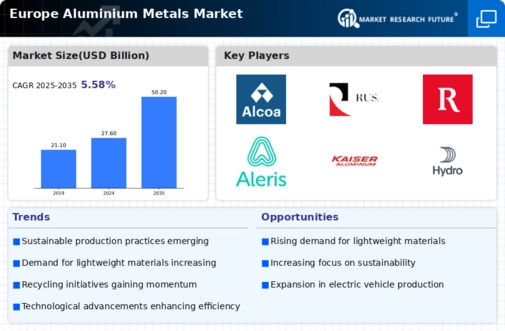The Europe Aluminium Metals Market has been characterized by its dynamic growth and intense competition among key players. Driven by the increasing demand from the automotive, construction, and packaging industries, various companies have been vying for market share by enhancing their production capacities and investing in technological advancements. The competition is further fueled by the emergence of innovative product offerings and sustainable practices aimed at reducing carbon footprints. As European regulations on emissions become stricter, companies are focusing on eco-friendly processes and recyclable materials.
This landscape presents both opportunities and challenges as firms strive to maintain competitive advantages while keeping pace with the rapidly evolving market conditions.Alcoa has established a significant foothold in the Europe Aluminium Metals Market, capitalizing on its extensive experience and strong brand reputation in the industry. The company has positioned itself as a leader in sustainable aluminium production, reflecting its commitment to environmental stewardship. Its strengths lie in its innovative approach to manufacturing, advanced technologies, and strategic partnerships that enhance operational efficiency. Alcoa's investment in recycling capabilities has allowed it to cater effectively to the growing demand for sustainable aluminium.
Furthermore, its product range includes high-quality aluminium sheets, extrusions, and primary metal products tailored specifically for European customers in various sectors, thereby reinforcing its market presence and customer loyalty.On the other hand, Rusal plays a crucial role in the Europe Aluminium Metals Market, integrating a wide array of aluminium solutions that cater to industrial applications across multiple sectors. The company has focused on expanding its operational footprint in Europe, making strategic investments to bolster its production capabilities and sustainable initiatives. Rusal's strengths include its advanced technological prowess in aluminium smelting and significant expertise in the production of low-carbon aluminium products.
Their portfolio encompasses products such as aluminium ingots, alloys, and rolled products, which are essential in automotive and construction applications. Rusal has also engaged in mergers and acquisitions to expand its influence and achieve operational synergies aimed at boosting its competitive position within Europe. The firm's commitment to sustainability and innovation, combined with its strong market presence, enables it to effectively meet the evolving needs of the European aluminium market.























Leave a Comment